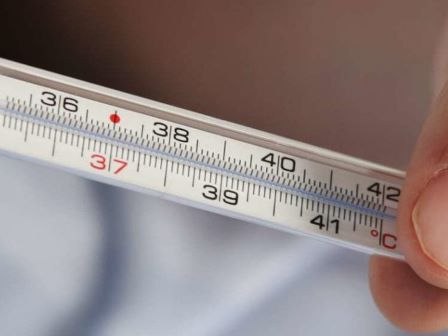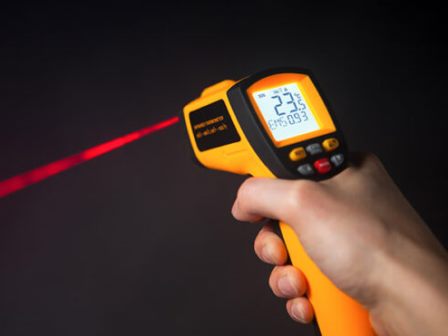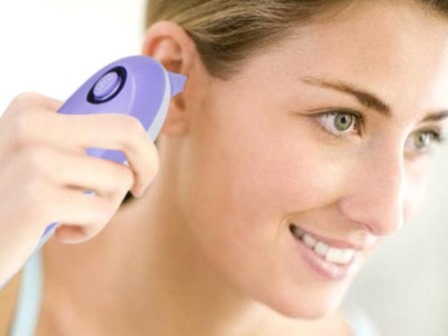Yes, you can use a general-purpose medical infrared thermometer to measure human-forehead temperature. Significant changes in the recording of human body temperature have been taking place worldwide in recent years.
Human body temperature is well established as one of the key vital signs. It is measured at regular intervals in the medical setting and often at home to try to estimate the degree of “sickness” of an individual. It had been used since antiquity, yet its interpretation had been and still is, actively debated in the clinical setting.
Can you use Infrared Thermometer on humans?

What is normal body temperature?
You may have heard that the “normal” body temperature is 98.6°F (37°C). This number is only an average. Your body temperature may be slightly higher or lower.
A body temperature reading that’s above or below the average doesn’t automatically mean you’re sick. A number of factors can influence your body temperature, including your age, sex, time of day, and activity level.
The first step towards understanding the relationship between temperature and disease is to define “normal” body temperature, from where deviations can be measured. In fact, many attempts were made to this end, to establish a link between fever and clinical diagnosis.
Research had shown that body temperature is a nonlinear function of several variables such as age, state of health, gender, environmental temperature, time of the diurnal cycle, among many others.

How to take temperature with infrared thermometer?
The main types of non-contact thermometers are non-contact infrared thermometers, and thermal scanners. Non-contact infrared thermometers are held three to 15 cm away from the patient and typically measure temperature on the forehead or temple.
Body temperature can be measured in a number of ways. Traditionally, body temperature has been measured using contact thermometers that are placed on the forehead or in the mouth.
Non-contact thermometers allow a person’s temperature to be taken with minimal or no contact with the person. This means the temperature can be measured without the discomfort of having to sit still with a thermometer in the mouth or armpit, long enough to obtain a correct temperature reading.
The lack of contact also means the disinfection process between patients for the thermometers is minimal or unnecessary, allowing for easier and faster use when screening large numbers of people in settings like airports or border crossings.

Can you use Infrared Thermometer on humans?
Yes, you can use a general-purpose medical infrared thermometer to measure human-forehead temperature.
Here is a step by step guide for how to operate a non-contact thermometer effectively for an accurate temperature reading:
-Power on the thermometer gun and hold the trigger until the laser appears
-Once the laser is emitted from the thermometer, point it in the direction of the object you are measuring and hold the end of the laser stable in a precise, center location
-Continue holding down the thermometer’s trigger while it reads the object’s temperature
-Once the temperature has been read, the thermometer will display this reading on the screen for you to record or take note of
-Power off the thermometer device after use
Infrared thermometers cannot typically be calibrated at home, but they are known for their low drift. If the results of your ice bath test are within your unit’s manufacturer’s listed specification, you are good to go.
Infrared thermometers usually use a lens to focus infrared light from one object onto a detector called a thermopile. The thermopile absorbs the infrared radiation and turns it into heat. The more infrared energy, the hotter the thermopile gets. This heat is turned into electricity.
Where to measure body temperature?
Body temperature is a measure of the body’s ability to generate and dissipate heat. In spite of large temperature variations in the environment, the body is able to control its temperature within a narrow range.
When one is hot, the blood vessels in the skin dilate and carry the excess heat to the skin surface. You begin to sweat and as the sweat evaporates it helps to cool the body.
Conversely, when the body is cold, the blood flow to the skin is decreased allowing conservation of body heat.
The involuntary act of shivering causes the muscles to generate more heat than can be conserved. Under normal conditions, these reactions of the body to hot and cold keep body temperature within a narrow safe range
Body temperature can be measured in many locations of the body. Most commonly temperature measurements are taken in the mouth, ear, armpit, or rectum. For convenience and accuracy, an ideal place to measure temperature is the forehead.

Normal Body Temperature
Body temperature is a characteristic of a person’s metabolic condition and therefore an indication of health. Traditionally, an oral temperature of 37°C/98.6°F has been considered “normal” body temperature. In fact, this figure is a result of a centuries-old study indicating the average temperature of the study group.
Body temperature is individual to the person and can vary on a healthy person by more than +/- 1°C from 37°C (98.6°F). Your body temperature is influenced by many factors including but not limited to the time of day, gender, age, ambient temperature, and metabolic activity.
Infrared thermometer for humans
There is an easier way to get an accurate temperature from humans without causing them any further discomfort. A digital infrared thermometer can be the answer to your problems. These digital thermometers do not require that you hold anything in your mouth or under the arm. In fact, they do not require any physical contact at all.
- Infrared thermometer for humans
- Ear digital thermometer
- Smart thermometer
- Temporal infrared thermometer
How to use infrared thermometer on humans?
Infrared Thermometer Guidelines
This specification covers infrared thermometers, which are electronic instruments intended for the intermittent measurement and monitoring of patient temperatures by means of detecting the intensity of thermal radiation between the subject of measurement and the sensor.
The specification addresses the assessment of the subject’s internal body temperature through the measurement of thermal emission from the ear canal.
Though, performance requirements for non-contact temperature measurement of skin are also provided. Limits are set for laboratory accuracy, and determination and disclosure of clinical accuracy of the covered instruments are required.
Performance and storage limits under various environmental conditions, requirements for labeling, and test procedures are all established herein.

How to use Infrared Thermometer on Humans?
Infrared thermometers can be used to measure human temperature, this can be done in a number of ways.

Celsius to Fahrenheit Fever
Human body temperature information and conversion tables include normal, high and low readings and fever readings from Celsius to Fahrenheit.

Laser Thermometer for Humans
The laser thermometer for humans measures the surface temperature of an object. The unit’s optics detect emitted energy that is collected and focused on a detector.
The most read

Infrared Thermometer for Humans
Infrared thermometers for humans allow users to measure body temperature quickly and non-invasively.
